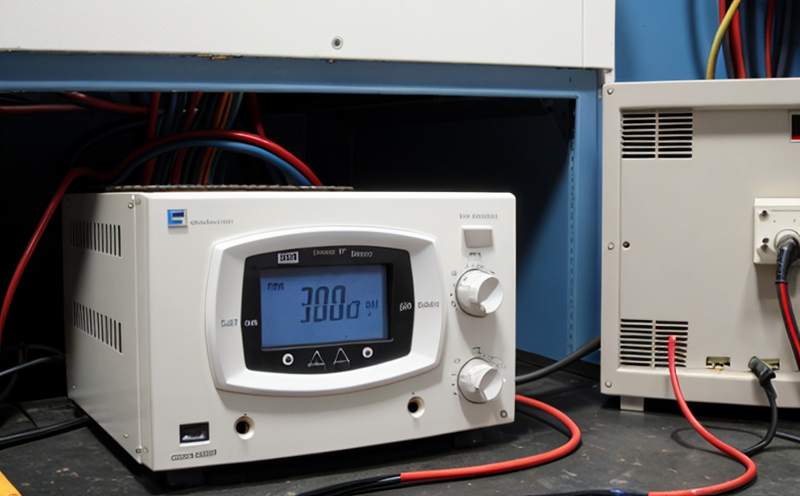IEC 60730 Electrical Endurance Testing of Automatic Lamp Controls
The International Electrotechnical Commission (IEC) standard IEC 60730 sets forth stringent requirements for the electrical endurance testing of automatic lamp controls. This standard ensures that these devices meet performance and safety criteria, which are critical in preventing malfunctions that could lead to fire hazards or other risks.
The primary focus of this test is on the longevity and reliability of the control circuits within automatic lamp controls. These controls often play a crucial role in lighting systems, especially in commercial, industrial, and residential settings where energy efficiency is paramount. By adhering to IEC 60730, manufacturers can demonstrate that their products are not only safe but also capable of operating under extreme conditions without degrading.
The test involves subjecting the automatic lamp controls to a series of electrical stressors designed to mimic real-world operating environments. This includes high and low voltage levels, varying temperature ranges, and other environmental factors. The goal is to assess how well the device can withstand these stresses over extended periods. The duration of this testing can vary depending on the specific requirements of the product being tested, but it typically spans several days or even weeks.
During the test, close monitoring is conducted using high-precision measurement instruments. These devices record data such as current flow, voltage fluctuations, and temperature changes throughout the endurance period. This data is crucial for evaluating whether the control circuits meet the specified performance criteria outlined in IEC 60730.
One of the key aspects of this testing method is the use of a controlled environment to simulate real-world conditions. This ensures that any issues identified during testing are directly related to the product's design and manufacturing process rather than external variables. The controlled environment allows for consistent results, which can be crucial when comparing different models or batches of products.
The importance of IEC 60730 cannot be overstated in today’s global market. Compliance with this standard is often a requirement for product certification, especially in countries that adopt the relevant national standards based on IEC recommendations. This ensures that consumers and users have confidence in the safety and reliability of the products they purchase.
Manufacturers who adhere to these stringent testing protocols not only enhance their reputation but also gain a competitive edge by producing high-quality products that meet international standards. In an era where energy efficiency is increasingly important, reliable automatic lamp controls are essential for reducing waste and conserving resources. By ensuring compliance with IEC 60730, companies can contribute to these broader environmental goals while maintaining their own business integrity.
| Standard | Description |
|---|---|
| IEC 60730-1 | General requirements for stand-alone electronic electric control devices, including automatic lamp controls |
| IEC 60730-2-1 | Test conditions and procedures for the specified tests |
The combination of rigorous testing protocols and international standards ensures that automatic lamp controls are not only safe but also efficient in their intended applications. This contributes to a safer, more sustainable future by promoting the use of reliable lighting solutions.
Applied Standards
- IEC 60730-1: General requirements for stand-alone electronic electric control devices
- IEC 60730-2-1: Test conditions and procedures for the specified tests
The application of these standards ensures that automatic lamp controls undergo thorough electrical endurance testing to meet stringent performance criteria. This includes assessing the device’s ability to withstand various stressors, such as voltage fluctuations and temperature variations, over extended periods.
Customer Impact and Satisfaction
- Enhanced safety: Compliance with IEC 60730 ensures that automatic lamp controls meet rigorous performance and safety standards, reducing the risk of electrical hazards.
- Improved reliability: The testing process identifies potential issues early in the development stage, leading to more reliable products that perform consistently over time.
- Increased confidence for consumers: By meeting international standards, manufacturers can build trust with customers who value quality and safety in their lighting solutions.
The implementation of IEC 60730 electrical endurance testing not only benefits the manufacturer but also provides significant advantages to end-users. Consumers gain peace of mind knowing that they are using products that have undergone rigorous testing, which can lead to higher satisfaction levels and repeat business.
Use Cases and Application Examples
- Commercial lighting systems: Ensuring the longevity and reliability of automatic lamp controls in large-scale commercial applications such as office buildings, hotels, and retail spaces.
- Industrial facilities: Providing reliable control for lighting in manufacturing plants where uptime is critical.
- Residential settings: Enhancing energy efficiency and safety in homes through dependable automatic lamp controls.
The versatility of IEC 60730 testing extends beyond just commercial and industrial applications. It also plays a crucial role in residential settings, particularly with the growing emphasis on smart home technologies and energy-efficient lighting solutions. In these environments, reliable automatic lamp controls are essential for maintaining both safety and efficiency.
For quality managers, compliance officers, R&D engineers, and procurement professionals involved in the development and sourcing of automatic lamp controls, adhering to IEC 60730 is a non-negotiable requirement. This standard provides a framework that ensures consistent performance across different models and batches, facilitating easier integration into existing systems.





